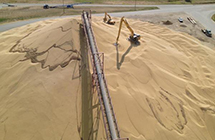 |
 |
|
| eNews • November 2018 | ||
| Promoting a Cost-Effective, Reliable and Competitive Transportation System |
||
 U.S. experiences 'soybean backup' as exporters struggle to sell
U.S. experiences 'soybean backup' as exporters struggle to sell
A dramatic change in the international soybean market created by the trade war between the United States and China has left soy exporters scrambling to not only find new buyers, but also reroute millions of bushels of beans across the country.
After the fall harvest, beans grown in the upper Midwest would normally be loaded onto rail cars bound for ports in Oregon and Washington state, where ports offer the fastest route to China. But high tariffs on U.S. soy have stopped China from buying American beans.
That leaves the millions of bushels planted last spring to meet the Chinese demand with nowhere to go.
Exporters are slowly finding new buyers in Europe, South America and Africa. But to reach those nations, the beans must be shipped from different U.S. ports, located either on the East Coast or the Gulf of Mexico. This creates a logistical challenge, as exporters look for ways to move massive quantities of soy to these new harbors.
"It's chaos, the whole system right now," said Bruce Abbe, president and CEO of the Midwest Shippers Association.
Carving new paths
For many areas of the Midwest, especially the upper Midwest, the shipping routes to the Gulf ports are less direct. Shippers trying to reach them are carving new paths -- trucking the beans for long distances to the Mississippi River, then loading them onto river barges for the remainder of the journey.
The harvest is just completing in most parts of the Midwest, and the nation's river system is seeing more soy. As exporters hurry to move their product south, backups are predicted in key river ports, like St. Louis.
The reason is America's soy industry is designed to supply beans to China.
China consumes huge quantities of soy and purchases about 30 percent of all the beans grown in the United States, mostly to feed livestock.
This trend grew over the last decade. China went from importing few beans in the early 1990s to becoming the world's largest buyer. In 2017, it imported more than twice as much soy as the 10 other top soy-consuming nations combined, according to numbers released by the U.S. Department of Agriculture.
To meet the explosive demand, U.S. farmers grew more soy.
A lot of that growth occurred in the upper-Midwest. Farmers in states like North and South Dakota and Minnesota, who had historically grown more wheat and barley, switched their crops.
In 2000, North Dakota produced 61 million bushels of soybeans, according to the Soy Transportation Coalition. In 2017, the state produced 240 million bushels -- nearly all of it bound for China.
The transportation industry responded, spending hundreds of millions of dollars on infrastructure to move beans from the Dakotas to the West Coast.
Railway lines were built within easy access of farms. The Columbia River shipping channel was dredged to accommodate increased barge activity. Export terminals emerged near the Pacific Ocean.
The resulting system that moves beans to China is simple, efficient and, now, effectively useless.
"What's happening is we have this harvest coming online right now, and it's going to be large, and farmers are trying to figure out, 'What do we do?'" said Mike Steenhoek, executive director of the Soy Transportation Coalition.
Storage options limited
Although a higher than usual amount will make its way to the Gulf for export to emerging international markets, the answer for many farmers will be to store their beans and hope the Chinese market returns.
"It's backing up soybeans through the country," said Rick Duesk, executive vice president for CHS country operations, which markets grain. "So it's really becoming a challenge to find places to store it."
Most farmers are able to store some beans on their farms, though usually not their whole harvest, Duesk said. Grain elevators -- companies that store and export grain -- are filling fast.
"We're hearing some grain elevators are not even looking to buy soy because they have no place to put it," Abbe said.
In some places, the beans are simply being piled on the ground, Duesk said.
Experts can't predict what comes next.
In the best-case scenario for American farmers and exporters, the trade war ends and the millions of bushels of stored beans are loaded onto barges for China.
There is little evidence of a swift end to the tariff battle. After imposing $53 billion in tariffs on Chinese imports over the summer, the Trump administration levied an additional $200 billion in late September and has threatened $267 billion more. The Chinese, in turn, imposed $50 billion in retaliatory tariffs over the summer, followed by $60 billion more in September. They've threatened $130 billion more.
If the trade war drags on, soy exporters will continue to find new buyers, said Chris Hurt, an economist at Purdue University. But, at least in the immediate future, those markets won't come close to replacing China.
"The way I describe it is, imagine you decide to open a sports bar across the street from a Major League Baseball stadium," Steenhoek said. "Then the baseball stadium moves. Now, someone will come along and say, 'Don't despair, you can find other customers.' But that's not a lot of consolation, because your business model is predicated on that baseball stadium. Without it, you really are in trouble.
"That's what's happening now with soybeans. So much of the growth in soybean production was based on the assumption that we'd have a steadily increasing demand from China. Now that's gone."
Source: UPI
Soy Transportation Coalition |
|
